Harbor Breeze CAF48LW5LRC Installation guide
- Category
- Household fans
- Type
- Installation guide
This manual is also suitable for

1
BAYOU CREEK CEILING FAN
ATTACH YOUR RECEIPT HERE
Purchase Date
Español p. 22
4009654
Questions, problems, missing parts? Before returning to your retailer, call our customer
service department at 1-800-527-1292, 8:30 a.m. - 5 p.m., CST, Monday - Friday
ITEM #0889801
#0889802
#0889803
MODEL #CAF48BNK5LRC
#CAF48OSB5LRC
#CAF48LW5LRC

READ AND SAVE THESE INSTRUCTIONS
• Do not discard fan carton or foam inserts. Should this fan need to be returned to the factory for
repairs, it must be shipped in its original packaging to ensure proper protection against damage that
might exceed the initial cause for return.
• Make sure all electrical connections comply with local codes, ordinances, the National Electrical
Code and ANSI/NFPA 70-1999. Hire a qualified electrician or consult a do-it-yourself wiring handbook
if you are unfamiliar with installing electrical wiring.
• Make sure the installation site you choose allows a minimum clearance of 7 ft. from the blades to the
floor and at least 30 in. from the end of the blades to any obstruction.
• After you install the fan, make sure all connections are secure to prevent the fan from falling.
• The net weight of CAF48 including the light kit is: 16 lbs.
Safety Information ................................................................................................................2
Package Contents ................................................................................................................4
Hardware Contents
...........................................................................................................................
5
Preparation ...........................................................................................................................5
Initial Installation ...................................................................................................................6
Wiring ...................................................................................................................................11
Final Installation ...................................................................................................................13
Installing Fan Without Light Kit ............................................................................................16
Operating Instructions .........................................................................................................17
Care and Maintenance ........................................................................................................19
Troubleshooting....................................................................................................................20
Warranty ..............................................................................................................................21
TABLE OF CONTENTS
2
SAFETY INFORMATION
When mounting fan to a ceiling outlet box, use a METAL octagonal outlet box; do NOT use a
plastic outlet box. Make sure the outlet box is securely attached to the building structure and can
support the full weight of the fan. The outlet box and its support must be able to support the
moving weight of the fan (at least 35 lbs.). Failure to do this can result in serious injury or
death. The stability of the outlet box is essential in minimizing wobble and noise in the fan after
installation is complete.
DANGER

3
SAFETY INFORMATION
To reduce the risk of fire, electrical shock or personal injury, mount fan to outlet box
marked "ACCEPTABLE FOR FAN SUPPORT OF 35 LBS. (15.9 KG) OR LESS" and use
mounting screws provided with the outlet box. Most outlet boxes commonly used for the
support of lighting fixtures are not acceptable for fan support and may need to be replaced.
Consult a qualified electrician if in doubt.
To avoid personal injury, the use of gloves may be necessary while handling fan parts with
sharp edges.
To reduce the risk of fire, electrical shock or personal injury, wire connectors provided with this fan
are designed to accept only one 12-gauge house wire and two lead wires from the fan. If your
house wire is larger than 12-gauge or there is more than one house wire to connect to the
corresponding fan lead wires, consult an electrician for the proper size wire connectors to use.
To reduce the risk of fire or electrical shock, do not use the fan with any solid state speed control
device or control fan speed with a full range dimmer switch.
To reduce the risk of fire, electrical shock or personal injury, do not bend the blade arms when
installing them, balancing the blades or cleaning the fan. Do not insert objects between the
rotating fan blades.
To reduce the risk of personal injury, use ONLY parts provided with this fan. The use of parts
OTHER than those provided with this fan will void the warranty.
Before installation, be sure to shut off electricity at main switch or circuit breaker in order to avoid
electrical shock.
WARNING
CAUTION
Be sure outlet box is properly grounded and that a ground wire (green or bare) is present.
Before beginning installation, carefully check all screws, bolts and nuts on fan motor assembly to
ensure they are secure.

IMPORTANT: You must use the parts
provided with this fan for proper installation and
safety.
A
Downrod 1
B
Canopy
1
C
Mounting Bracket
1
(preassembled)
D Motor Housing 1
E
Yoke Cover 1
F Light Kit Fitter 1
G
Blade
5
H
Bulb
2
I Finial Plate (preassembled) 1
J Blade Arm 5
K Hex Nut (preassembled) 2
L Lock Washer (preassembled) 1
M Switch Housing Cap 1
(preassembled)
DESCRIPTIONPART
QUANTITY
N Switch Housing Cap Screw 3
(preassembled)
O Finial (preassembled) 1
P Glass Shade 1
Q Rubber Washer 1
(preassembled)
R Balancing Kit 1
S Motor Screw 10
(preassembled) + 1 extra
T Washer (preassembled) 10
+ 1 extra
U Remote Pack 1
V Remote Control Receiver 1
W Pin (preassembled) 1
X Clip (preassembled) 1
Y Star Washer (preassembled) 4
Z Canopy Mounting Screw 4
(preassembled)
DESCRIPTIONPART
QUANTITY
PACKAGE CONTENTS
4
E
D
B
H
C
G
J
L
K
I
F
M
P
N
O
Q
R
T
S
U
V
A
W
X
Z
Y

5
PREPARATION
HARDWARE CONTENTS (shown actual size)
AA
BB
Cap
Qty. 1
CC
DD
Before beginning assembly of product, make sure all parts are present. Place motor on carpet or on
foam to avoid damage to finish. Compare parts with package contents list and hardware contents list.
If any part is missing or damaged, do not attempt to install, operate or assemble the product.
Estimated Assembly Time: 120 minutes
Tools Required for Assembly (not included): Electrical Tape, Phillips Screwdriver, Pliers, Safety
Glasses, Stepladder and Wire Strippers
Helpful Tools (not included): AC Tester Light, Tape Measure, Do-It-Yourself Wiring Handbook and
Wire Cutters
Fiber
Blade
Washer
Qty. 15
+ 1 extra
Blade
Screw
Qty. 15
+ 1 extra
Wire
Connector
Qty. 4

6
INITIAL INSTALLATION
Turn off circuit breakers and wall switch to the fan
supply line leads.
DANGER: Failure to disconnect power supply
prior to installation may result in serious injury or
death.
1.
Check to make sure blades (G) will be at least 30
inches from any obstruction and at least 7 ft. above
the floor.
3.
ON
OFF
ON
OFF
1
3
2.
Determine mounting method to use.
A. Downrod mount (standard or angled ceiling)
B. Closemount (standard ceiling only)
IMPORTANT: If using the angle mount, check to
make sure the ceiling angle is not steeper than 19°.
*Helpful Hint: Downrod-style mounting is best
suited for ceilings 8 ft. or higher. For taller ceilings
you may want to use a longer downrod (not
included). Angle-style mounting is best suited for
angled or vaulted ceilings. A longer downrod is
sometimes necessary to ensure proper blade
clearance. Closemount-style mounting is more
suitable for ceilings lower than 8 ft.
2
A
B
19° max.
7 ft.
min.
30 in.
min.
G

INITIAL INSTALLATION
7
4a.
Loosen canopy mounting screws (Z) in slotted
holes of canopy (B) and remove the other two
canopy mounting screws (Z) and star washers
(Y). Save for later use.
Remove mounting bracket (C) from canopy (B).
Secure mounting bracket (C) to outlet box (not
included) using screws, spring washers and flat
washers provided with the outlet box.
NOTE: It is very important you use the proper
hardware when installing the mounting bracket
(C) as this will support the fan.
IMPORTANT: If using the angle mount, make
sure open end of mounting bracket (C) is
installed facing the higher point of the ceiling,
and ensure the ceiling angle is not steeper than
19º.
4b.
4b
4a
C
Z
B
Y
Open End
C
C
ANGLE
MOUNT
STANDARD
MOUNT
5.
Remove preassembled motor screws (S) and
washers (T) from underside of motor housing (D). If
there are plastic motor blocks installed with the
motor screws (S), discard the plastic motor blocks.
Note: Make sure to keep loose hardware separate
to avoid confusion during installation.
For DOWNROD-STYLE FAN MOUNTING,
proceed to step 1 on the next page.
For CLOSEMOUNT-STYLE FAN MOUNTING,
skip to page 10.
5
S
T
D
Plastic
Motor
Block

8
DOWNROD-STYLE FAN MOUNTING
Remove pin (W) and clip (X) from downrod (A).
Partially loosen preassembled set screws and nuts
in motor housing yoke at top of motor housing (D).
1.
1
X
D
W
A
Yoke
Set Screw
and Nut
Sideview
2.
Insert downrod (A) through canopy (B) and yoke
cover (E). Then, thread wires from motor
housing (D) up through downrod (A).
2
B
A
3.
Slip downrod (A) into yoke, align holes and
re-install pin (W) and clip (X). Tighten set screws
and then tighten nuts. Slide yoke cover (E) down
until it rests on top of motor housing (D).
E
D
A
W
E
B
3
X
W
Set Screw
and Nut
Sideview
Yoke

9
DOWNROD-STYLE FAN MOUNTING
Depending on the length of downrod you use,
you may need to cut the lead wires back to
simplify the wiring. If you decide to cut back the
lead wires, it is suggested you do so in the
following manner:
Take the lead wires and make sure you have
pulled them all the way through the top of the
downrod. Start at the TOP of the hanging ball on
the downrod and measure 8 in. of lead wire, and
then cut the excess wire off with wire cutters (not
included).
NOTE: If you do not cut back the lead wires,
Steps 4 and 5 are not necessary and you may
proceed to Step 6 instead.
4.
Hanging
Ball
4
8 in.
6.
If you decided to cut back the lead wires in Step 4,
strip 1/2 in. of insulation from end of each
wire -- white, black, green and blue (if applicable).
Twist stripped ends of each strand of wire within
the insulation with pliers (not included).
5.
5
Install hanging ball of downrod (A) into opening of
mounting bracket (C). Align one of the slots in
hanging ball with tab in mounting bracket (C).
DANGER: Failure to align one of the slots in
the ball with the tab may result in serious injury or
death.
Hanging
Ball Slot
A
6
Tab
C

10
CLOSEMOUNT-STYLE FAN MOUNTING
Remove preassembled canopy cover from bottom of
canopy (B). NOTE: It may be necessary to use the
handle end of a screwdriver (not included) to remove
the canopy cover by tapping on the canopy cover
from the inside of the canopy (B).
NOTE: The downrod (A), yoke cover (E) and canopy
cover are not used in this type of installation.
1.
1
3.
Pull wires up through hole in the middle of the
canopy (B) and attach canopy (B) to motor
housing (D) using three screws and lock washers
previously removed.
Canopy
Cover
B
3
Remove every other preassembled screw and lock
washer from top of motor housing (D).
2.
2
D
B
D
J

11
Temporarily hang fan on the tab on the mounting
bracket (C) using one of the non-slotted holes in
the canopy (B).
4.
C
4
WARNING: To reduce the risk of fire, electrical shock or personal injury, each wire connector
provided with this fan is designed to accept only one 12-gauge house wire and one lead wire from
the fan. If your house wire is larger than 12-gauge or there is more than one house wire to
connect to the corresponding fixture lead wires, consult an electrician.
CAUTION: Be sure outlet box is properly grounded and that a ground (green or bare) wire is present.
WARNING: The wires from the outlet box must be connected to a corresponding color of the
fan's wires. Be sure wire colors match before making connections. If house wires are different
colors than referred to in the following steps, stop immediately. A professional electrician is
recommended to determine wiring.
WIRING
WARNING: Using a full range dimmer switch (not included) to control fan speed will cause
a loud humming noise from fan. To reduce the risk of fire or electrical shock, do NOT use a full
range dimmer switch to control fan speed.
CLOSEMOUNT-STYLE FAN MOUNTING
Tab
Hole
B

12
WIRING
Wrap electrical tape (not included) around each
individual wire connector (DD) down to the wire.
WARNING: Make sure no bare wire or wire
strands are visible after making connections. Place
GREEN and WHITE connections on opposite side of
the outlet box from the BLACK and BLUE (if
applicable) connections.
2.
DD
2
DD
DD
1.
Make the necessary wiring connections for
remote control operation as detailed below and
in the figure. For each wire connection, use one
of the wire connectors (DD), making sure to
screw wire connector (DD) on in a clockwise
direction.
CAUTION: Assistance from another person is
recommended for this step.
Connect all GROUND (GREEN) wires from fan
(on downrod (A), if applicable, and mounting
bracket (C)) to BARE/GREEN supply wire from
ceiling.
Connect BLACK wire (labeled AC IN L) from
remote control receiver (H) to BLACK supply
wire from ceiling.
Connect WHITE wire (labeled AC IN N) from
remote control receiver (H) to WHITE supply
wire from ceiling.
Connect WHITE wire (labeled TO MOTOR N)
from remote control receiver (H) to WHITE wire
from motor housing (D).
Connect BLACK wire (labeled TO MOTOR L)
from remote control receiver (H) to BLACK wire
from motor housing (D).
Connect BLUE wire (labeled FOR LIGHT) from
remote control receiver (H) to BLUE wire from
motor housing (D).
Hardware Used
Wire Connector
x 6
DD
V
1
WHITE SUPPLY WIRE
BLACK SUPPLY WIRE
BLACK
BLACK
WHITE
BLUE
BLUE
WHITE
BLACK
AC IN L
WHITE
AC IN N
WHITE
GROUND (GREEN OR BARE)
GROUND
(GREEN OR BARE)
BLACK
FROM
RECEIVER
FROM
FAN
FROM
RECEIVER
FROM
CEILING

1
13
WIRING
1.
Lift canopy (B) to mounting bracket (C) and
align slotted holes in canopy (B) with loosened
canopy mounting screws (Z) in mounting
bracket (C). Twist canopy (B) to lock, then
insert the two canopy mounting screws (Z) and
star washers (Y) previously removed (Step 4a,
page 7). Tighten all canopy mounting screws
(Z) securely.
2.
2
Partially insert three blade screws (BB) along with
three blade washers (CC) into holes in blade (G).
Align pegs on blade arm (J) with blade screws (BB),
securing blade arm (J) to blade (G) by tightening
blade screws (BB) starting with the one in the
middle.
Repeat for remaining blades (G) and blade arms (J).
Hardware Used
Blade Screw
x 15
BB
Blade Washer
x 15
CC
CC
BB
G
J
Downrod
Closemount
B
B
A
D
D
Z
Y
FINAL INSTALLATION
3
Gently slide remote control receiver (V) flat-side up
into mounting bracket (C). Turn spliced/taped wires
upward and gently push wires and wire connectors
(DD) into outlet box. Let antenna from remote control
receiver (V) hang to the side.
NOTE: The remote control included with this fan
meets the following requirements:
a. Not for use with solid state fans.
b. Electrical rating: 120V / 60 Hz;
motor amps:1.25 MAX.;
light watts: 190
(Incandescent only)
Should you choose to use a different remote control
with this fan, it must also meet these same
requirements.
3.
Antenna
A
V
C

14
FINAL INSTALLATION
If you wish to use the fan with the light kit, remove
the three preassembled switch housing cap screws
(N) from switch housing cap (M) located at top of
light kit fitter (F).
Locate the BLUE (or BLACK) and WHITE molex
wires in the switch housing preassembled on motor
housing (D) that are labeled FOR LIGHT and
remove plastic from these two wires.
4.
5.
Connect WHITE molex wire from switch housing to
WHITE molex wire from light kit fitter (F). Connect
BLUE (or BLACK) molex wire from switch housing
to BLACK molex wire from light kit fitter (F). Make
sure molex connections are secure.
Then, align holes in switch housing cap (M) with
holes in switch housing. Note: Make sure to align
notch on top edge of the switch housing cap (M)
with the reverse switch on switch housing for the
correct fit.
Re-insert the switch housing screws (N) previously
removed (Step 4 above), then tighten all switch
housing cap screws (N) with a Phillips screwdriver
(not included).
N
M
F
N
N
N
M
Notch
5
Molex
Connections
D
Switch
Housing
Attach blade arms (J) to the bottom of motor
housing (D) with motor screws (S) and washers (T)
previously removed (Step 5, page 7). Tighten motor
screws (S) securely.
Note: Make sure to completely secure each blade
arm (J) before proceeding to the next.
3.
3
D
G
J
If you do NOT wish to use the light kit, skip
to INSTALLING FAN WITHOUT LIGHT KIT on
page 16.
If you DO wish to use the light kit, proceed to
Step 4.
4
D
Switch
Housing
White
Blue (or Black)
J
T
S
Reverse
Switch

15
Install bulbs (H).
CAUTION: When replacing bulb(s), allow
bulb(s) and glass shade to cool down before
touching.
7
7.
8.
Place rubber washer (Q) inside glass shade (P)
over center hole. Align hole in center of glass
shade (P) with threaded rod on light kit fitter (F).
Push up gently on glass shade (P) until threaded
rod comes through hole. Secure glass shade (P)
with hex nut (K).
CAUTION: Do NOT overtighten hex nut (K)
as glass may crack or break.
Then, align hole in center of finial plate (I) with
threaded rod and push up. Secure with finial (O).
CAUTION: Do NOT overtighten finial (O) as
glass may crack or break.
H
8
P
O
I
F
K
H
Q
Remove finial (O), finial plate (I), hex nut (K)
and rubber washer (Q) from the threaded rod
at the bottom of the light kit fitter (F). Save for
later use.
6.
6
Threaded
Rod
O
I
Q
F
K
FINAL INSTALLATION

16
If you wish to use the fan WITHOUT the light kit,
remove the three preassembled switch housing cap
screws (N) from switch housing cap (M) located at
top of light kit fitter (F).
Remove the preassembled hex nut (K) and lock
washer (L) from threaded rod at the top of light kit
fitter (F). Unscrew switch housing cap (M) to remove
it from the light kit fitter (F), and then gently feed the
BLACK and WHITE wires from the light kit fitter (F)
out through the hole in the middle of the switch
housing cap (M).
F
L
M
K
WHITE
BLACK
1.
1
2.
Hardware Used
Cap
x 1
AA
Place cap (AA) firmly in hole in middle of switch
housing cap (M). Align holes in switch housing cap
(M) with holes in switch housing, then attach switch
housing cap (M) with previously removed switch
housing cap screws (N). Note: Make sure to align
notch on top edge of the switch housing cap (M) with
the reverse switch on switch housing for the correct
fit.
2
AA
N
N
M
9
Remote Control
Bracket
Wall
9.
If you wish to use the remote control bracket from
remote pack (U), install screws from remote pack (U)
through bracket and into the desired installation site.
The remote control transmitter from remote pack (U)
rests inside the bracket.
Bracket
Screws
Switch
Housing
INSTALLING FAN WITHOUT LIGHT KIT
FINAL INSTALLATION
Notch
Reverse
Switch

17
CAUTION: The remote control transmitter can be programmed to multiple receivers or fans.
If this is not desired, turn wall switch off to any other programmable receiver or fan.
OPERATING INSTRUCTIONS
FCC Compliance Notice for Remote Control
Modifications not approved by the party responsible for compliance could void the user's authority
to operate the equipment.
*NOTE: This equipment has been tested and found to comply with the limits for a Class B digital
device, pursuant to Part 15 of the FCC Rules. These limits are designed to provide reasonable
protection against harmful interference in a residential installation. This equipment generates,
uses and can radiate radio frequency energy and, if not installed and used in accordance with
the instructions, may cause harmful interference to radio communications. However, there is no
guarantee that interference will not occur in a particular installation. If this equipment does cause
harmful interference to radio or television reception, which can be determined by turning the
equipment off and on, the user is encouraged to try to correct the interference by one or more of
the following measures:
* Reorient or relocate the receiving antenna.
* Increase the separation between the equipment and receiver.
* Connect the equipment into an outlet on a circuit different from that to which the
receiver is connected.
Consult the dealer or an experienced radio/TV technician for help.
Remove battery cover from back of remote
control transmitter in remote pack (U). Install
battery from remote pack (U) with positive (+)
end toward top of remote control transmitter.
Replace battery cover on remote control
transmitter.
WARNING: Choking Hazard - Small parts.
Keep battery away from children.
1.
(back
side)
1
Battery
Cover
U
CAUTION: “DO NOT DISPOSE OF BATTERIES IN FIRE, BATTERIES MAY EXPLODE OR
LEAK.” - When disposing of household alkaline batteries, it is best to check with your local and
state recycling or household hazardous waste coordinators concerning the specifics of the
program in your area. You may also locate a recycling center by calling 1-800-8-BATTERY or
1-877-2-RECYCLE or visit www.epa.gov/epawaste/index.htm or www.earth911.org for more
information.
Remote
Control
Transmitter
Battery

18
2.
Restore electrical power. Within 30 seconds of
restoring electrical power, press and hold the “0”
button on the remote control transmitter for 5 seconds
or until light on the fan blinks twice. Use the remote
control transmitter to test the light and fan functions to
confirm the learning process is complete.
NOTE: Remove protective covering from front of
remote control transmitter and discard.
IMPORTANT: To prevent damage to remote control
transmitter, remove the battery if not used for long
periods. Store the remote control transmitter away
from excess heat or humidity.
OPERATING INSTRUCTIONS
Operation buttons on the panel of the remote control
transmitter:
3 button for fan HIGH speed
2 button for fan MEDIUM speed
1 button for fan LOW speed
0 button to turn fan OFF
button to turn light ON or OFF
Tap button quickly to turn lights off or on. Hold
button down to increase or decrease lights. If you
press button in excess of 0.7 seconds, it
becomes a dimmer. The lights vary cyclically in
8 seconds. The light button has an auto resume
function, which keeps the light at the same
brightness as the last time it was turned off.
3.
4.
Use the fan reverse switch on the switch housing to
optimize the fan for seasonal performance. A ceiling
fan will allow you to raise your thermostat setting in
summer and lower your thermostat setting in winter
without feeling a difference in your comfort.
CAUTION: Turn fan off at wall switch and let
blades (G) come to a complete stop before manually
activating the reverse switch.
4
Switch
Housing
Reverse
Switch
2
Remote Control Transmitter
3
Remote Control Transmitter

OPERATING INSTRUCTIONS
19
4a. In warmer weather, setting the reverse switch
in the DOWN position will result in downward
airflow creating a wind chill effect.
4b. In cooler weather, setting the reverse switch in
the UP position will result in upward airflow that
can help move stagnant, hot air off the ceiling
area.
4c. IMPORTANT: Reverse switch must be set
either completely UP or completely DOWN for
fan to function. If the reverse switch is set in the
middle position, fan will not operate.
4a
4b
4c
CARE AND MAINTENANCE
At least twice each year, lower canopy (B) to check downrod (A) assembly, and then tighten all
screws on fan. Clean motor housing (D) with only a soft brush or lint-free cloth to avoid scratching the
finish. Clean blades (G) with a lint-free cloth. You may occasionally apply a light coat of furniture
polish to wood blades for added protection.
IMPORTANT: Shut off main power supply before beginning any maintenance. Do not use water or a
damp cloth to clean the ceiling fan.
Bulb Replacement: Use standard-base 6.5-watt LED bulbs or incandescent/CFL equivalent, up to 60
watts.
Battery Replacement: Use 12-volt alkaline battery.

20
1. Push switch firmly either up or
down.
2. Turn power on or check fuse.
3. Turn power off. Loosen motor
housing and check all
connections.
4. Turn off power and repeat
instructions in Step 2 on page 18.
1. Reverse switch not engaged.
2. Power is off or fuse is blown.
3. Faulty wire connection.
4. Learning code process between fan
and remote control transmitter may
not have been successful and
learning code was not activated.
WARNING: Before beginning work, shut off the power supply to avoid electrical shock.
PROBLEM POSSIBLE CAUSE CORRECTIVE ACTION
Fan does not
move.
Noisy operation.
1. Blades are loose.
2. Cracked blade.
3. Full range dimmer switch.
4. Fan is new.
5. Motor housing is loose.
1. Tighten all blade screws.
2. Replace blade.
3. Replace with an approved speed
control device.
4. Allow fan a “break in” period of a
few days, especially when running
the fan at Medium and High
speeds.
5. Verify mounting bracket is secure
according to instructions on page
7.
TROUBLESHOOTING
Excessive
wobbling.
1. Blades are loose.
2. Blade arms incorrectly attached.
3. Unbalanced blades.
4. Fan not securely mounted.
1. Tighten all blade screws.
2. Re-install blade arms.
3. Switch one blade with a blade
from the opposite side or use
balancing kit (R).
4. Verify mounting bracket is secure.
1. Re-install bulb(s).
2. Check wires in outlet box and, if
necessary, re-wire according to
instructions on page 11.
3. Make sure wall switch to light is
on.
4. Check molex connections in light
kit fitter and ensure they are
connected properly according to
instructions on page 14.
1. Bulb(s) not installed correctly.
2. Wires in outlet box not wired
properly.
3. Wall switch to light is off.
4. Wires in light kit fitter not wired
correctly.
Fan operates but
light fails.
NOTE: A small amount of "wobble" is normal and should not be considered a defect.
Page is loading ...
-
 1
1
-
 2
2
-
 3
3
-
 4
4
-
 5
5
-
 6
6
-
 7
7
-
 8
8
-
 9
9
-
 10
10
-
 11
11
-
 12
12
-
 13
13
-
 14
14
-
 15
15
-
 16
16
-
 17
17
-
 18
18
-
 19
19
-
 20
20
-
 21
21
Harbor Breeze CAF48LW5LRC Installation guide
- Category
- Household fans
- Type
- Installation guide
- This manual is also suitable for
Ask a question and I''ll find the answer in the document
Finding information in a document is now easier with AI
Related papers
-
Harbor Breeze 42473 User manual
-
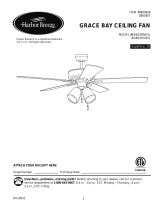 Harbor Breeze BDB52MBK5LS Installation guide
Harbor Breeze BDB52MBK5LS Installation guide
-
 Harbor Breeze 40678 User manual
Harbor Breeze 40678 User manual
-
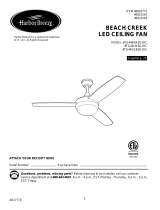 Harbor Breeze TG44OSB3D1RC User manual
Harbor Breeze TG44OSB3D1RC User manual
-
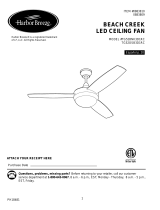 Harbor Breeze TG52MBK3D1RC Installation guide
Harbor Breeze TG52MBK3D1RC Installation guide
-
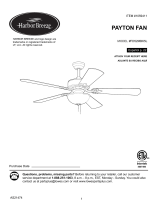 Harbor Breeze FD52MBK5L Flush Mount Ceiling Fan User manual
Harbor Breeze FD52MBK5L Flush Mount Ceiling Fan User manual
-
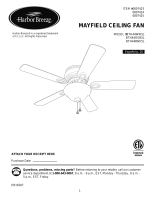 Harbor Breeze BTH44OSB5L Installation guide
Harbor Breeze BTH44OSB5L Installation guide
-
 Harbor Breeze 40958 Installation guide
Harbor Breeze 40958 Installation guide
-
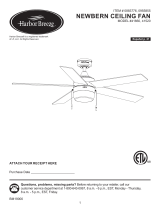 Harbor Breeze 41660 Installation guide
Harbor Breeze 41660 Installation guide
-
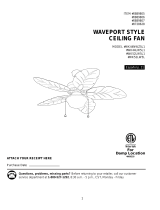 Harbor Breeze WK44NWZ5L1 Installation guide
Harbor Breeze WK44NWZ5L1 Installation guide
Other documents
-
Imperial G3030SD4BL Wire Diagram SD4
-
Monte Carlo Fan Company Crystoria Owner's manual
-
Carro HWGS-525A2-L11-WN-1 Installation guide
-
AireRyder LK51216NB User guide
-
Trend TT80015AB User manual
-
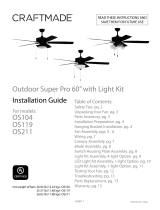 Craftmade OS104 Installation guide
Craftmade OS104 Installation guide
-
Prominence Home 40278 Owner's manual
-
Craftmade OP104 Installation guide
-
Triarch 31551 User manual
-
AireRyder FN433 series Instructions For Installation And Use Manual






























